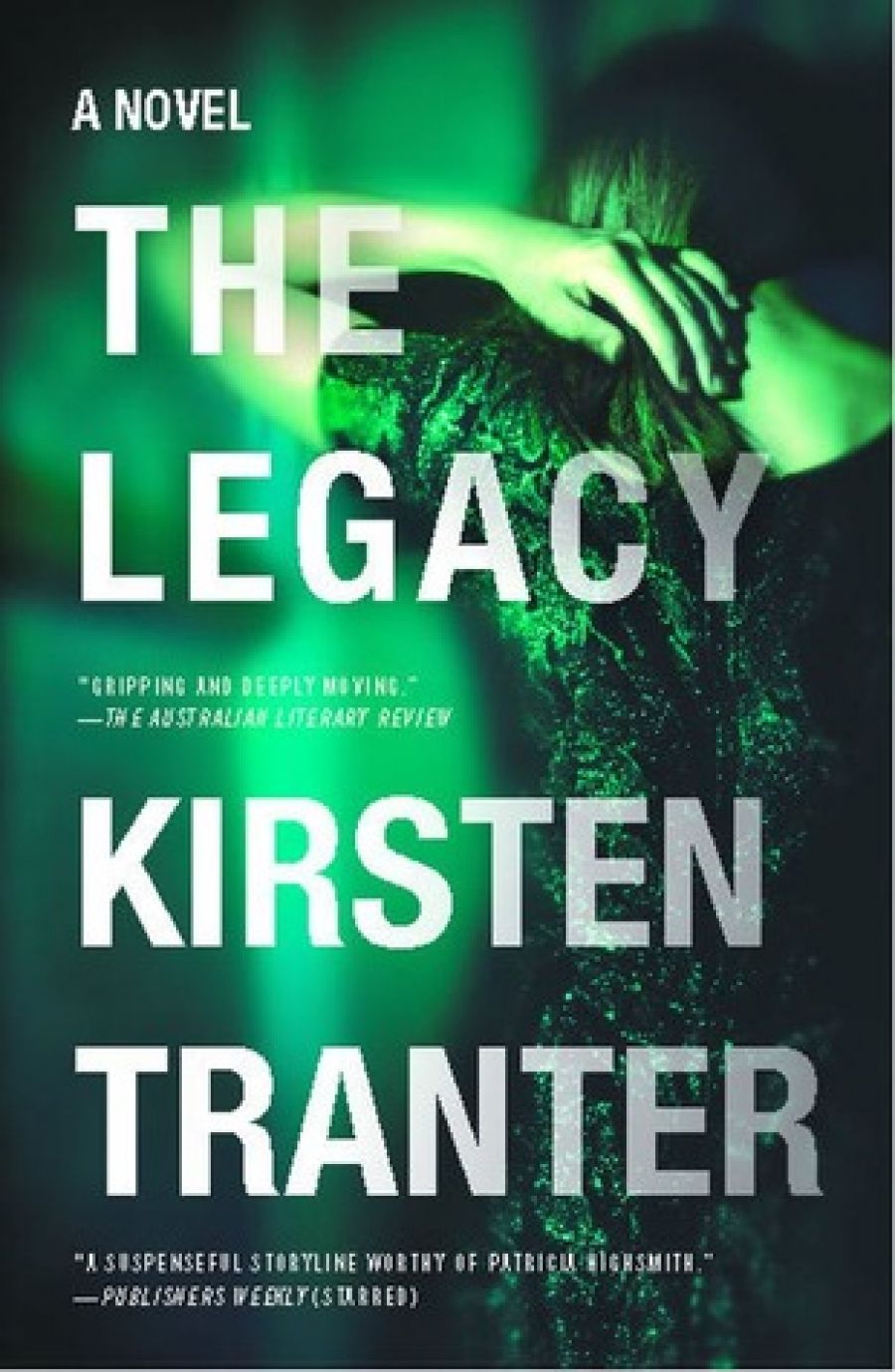
- Free Article: No
- Contents Category: Fiction
- Review Article: Yes
- Article Title: What Ingrid did next
- Article Subtitle: Isabel Archer in Manhattan
- Online Only: No
- Custom Highlight Text:
This highly ambitious first novel exists within a fine web of literary influences and allusions. The publisher invites comparisons to The Secret History, Donna Tartt’s novel set in a university Classics department. The novel’s narrator, Julia, a student enthralled by the glamorous, moneyed family of a classmate, echoes that of Brideshead Revisited. Self-conscious references to detective noir and nineteenth-century romance novels abound. All of these comparisons have some merit, but another takes precedence, not only flavouring the text, but providing a skeleton for the characters and plot
- Book 1 Title: The Legacy
- Book 1 Biblio: Fourth Estate, $32.99 pb, 464 pp
- Book 1 Readings Link: https://www.booktopia.com.au/the-legacy-kirsten-tranter/book/9780732290818.html
Done well, contemporary twists on classics can serve to interrogate or highlight the values and social mores of contemporary society by comparing them with the past, or show up the dissonance (or similarities) between past and present values and behaviour by transposing them to a more modern setting. For instance, the movie Clueless and the book Bridget Jones’s Diary play with classic Austen plotlines and archetypes (Emma and Pride and Prejudice, respectively) to show that the rituals of dating and courtship are not so different in the seeming hypermodern worlds of moneyed Los Angeles teens and hip thirty-something Londoners from how they were conducted in Austen’s refined world.
But what is the point of The Legacy’s use of Portrait of a Lady? On one level, it is a terrific conceit, illustrating the cold materialism, calculated posturing, and restrictive social structures of New York society by comparing it to the European society of James’s novel. (In fact, Jeffrey Eugenides, an admirer of Portrait, remarked in a Salon article some years ago that he sees ‘fierce-minded’ Isabel Archers and ‘creepy, loathsome’ Gilbert Osmonds everywhere in New York.) The tension between the old and the new worlds, epitomised by the split between America and Europe in Portrait, is replicated here in the divide between Australia and America – the new centre of the world. But it doesn’t quite work, perhaps partly because the reader doesn’t get an entrée into the world of New York society.
We see it very much from the fringes, from the perspective of Julia’s distant observations of Ingrid. Even when Julia travels to New York to investigate Ingrid’s life following her disappearance, the world she enters is that of Columbia University’s Classics department where Ingrid studied (hence the Secret History comparisons). The people she meets knew little about Ingrid’s life with Gilbert Grey, apart from the oft-repeated fact that she was ‘very unhappy’. And the one who does know – Fleur – isn’t telling, beyond vague hints.
The novel is preoccupied with the idea of the doomed girl and with unravelling the mystery surrounding her. The plot is divided between setting her up as the golden-haired girl with limitless potential (beauty, brains, money), then examining her largely unknown life after the misstep that caused her to squander it – and, eventually, investigating the possibility that she escaped to start again.
Like another famous doomed girl, Twin Peaks’ Laura Palmer, Ingrid is ‘full of secrets’. It is these secrets – and the deliciousness of mystery itself – that seems to be the novel’s real preoccupation. Several of the key characters Julia encounters in New York have special abilities when it comes to decoding secrets: there is Ingrid’s Classics colleague Trinh, the dominatrix who knows people’s secret desires; Richard the graphologist, who can decode the clues in people’s handwriting; Julia’s neighbour Mrs Bee, the psychic; and Julia herself is an expert amateur thief, able to spirit away clues for further investigation.
But the biggest secret isn’t what happened to Ingrid – it’s her motivation. Why did she choose Grey? More importantly, why did she stay with him after his true nature was revealed? She chose him out of perversity – just as Isabel Archer chose Gilbert Osmond. But she stayed with him out of an equally perverse pride, an unwillingness to be proved wrong. ‘She couldn’t stand to fail at anything ... She was still playing out ... this idea of the perfect marriage. And she hated being shamed more than anything.’ Somehow this doesn’t ring true, perhaps because the characters – especially Ingrid – are so loosely sketched that none of them rises much above archetype or caricature. We are almost drowned in surface detail about how the characters look, how they are dressed in each scene, and their physical surroundings. Often this detail serves little purpose, and the sheer volume of it highlights the lack of imagination working below the surface of things (ironically, since this kind of speculative leapfrogging is a preoccupation of Portrait). Tranter seems uncomfortably aware of this shortcoming – the novel is peppered with awkward narratorial acknowledgements of ‘cliché’-like relationships, ‘overly theatrical’ gestures, and ‘overdrawn’ or ‘conventional’ metaphors.
In the end, this is a psychological novel without any great insight. Unfortunately, like its heroine, The Legacy has a ‘sense of vivid potentiality’, but dashes itself on the rocks of its own misdirected ambitions.


Comments powered by CComment